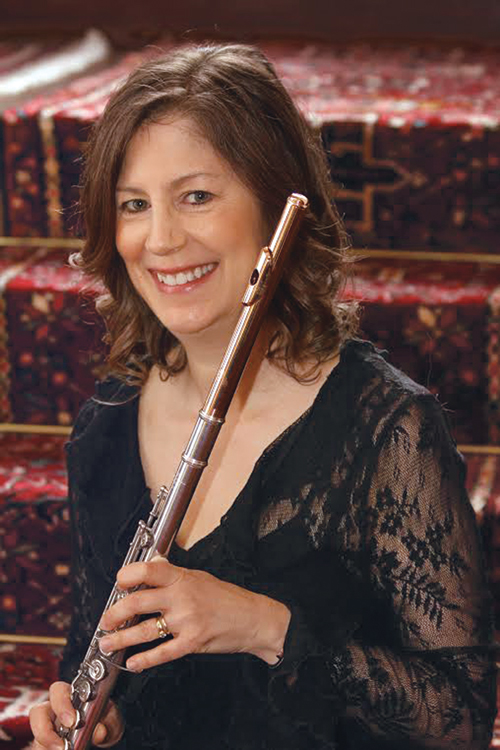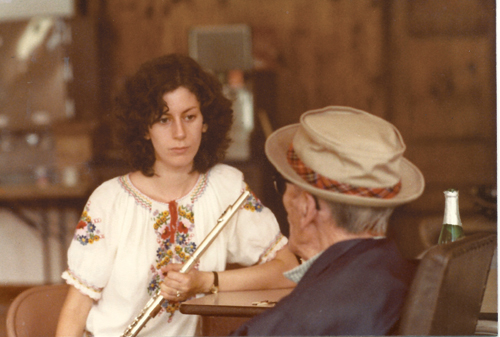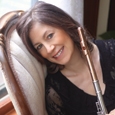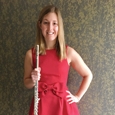
Julia Bogorad-Kogan became principal flute of The Saint Paul Chamber Orchestra at the age of 22. A frequent performer, she currently teaches at the University of Minnesota School of Music and gives masterclasses and recitals at colleges across the country.
How did you win the principal flute position with The Saint Paul Chamber Orchestra?
I really appreciated the fact that the audition consisted of more than just the ten most technical measures of Prokofiev’s Classical Symphony. In addition to the standard excerpts, I played a piece of my choice, Georges Enesco’s Cantabile et Presto, part of Hindemith’s Acht Stücke, a Reicha wind quintet with SPCO members, and a flute duet with my predecessor, Carol Wincenc. This allowed me to express my musical personality. So many auditions these days heavily favor technical excerpts and as a result reward those with the most bionic technique, even though they may not have anything to say musically when they get into the orchestra.
The SPCO is the only full-time chamber orchestra in the US. What is the difference between a chamber orchestra and a symphony orchestra?
A chamber orchestra is a small orchestra and can be anywhere from 18 to 50 or so musicians. It has a different core repertoire from a symphony orchestra, consisting generally of Baroque, Classical, twentieth-century and contemporary works with a few Romantic ones as well. There is often room for more individual expression in a chamber orchestra.
The SPCO has recently been including unconducted concerts in their season. When there is no conductor, the musicians have to come to the first rehearsal with a familiarity of the score and how their parts fit in. It requires a lot more preparation. The first rehearsal is often chaotic. We have to painstakingly work out who leads in each section of a piece. At one point, I may watch the concertmaster, then listen to the second violins, then act as a leader in cueing the wind section for a tutti wind choir. Usually, one of the two concertmasters is the overall leader of the rehearsals, but anyone is free to put in his or her two cents, and they frequently do. It takes time, but we gradually hash out a unified concept of the piece. Concerts can sometimes be disastrous but also electrifying because everyone is on edge. It is quite a high-wire act.
What are your favorite pre-concert rituals?
I always nap in the afternoon before a concert. For me, the quality of the nap predicts the quality of the concert. I also make sure to eat dinner, as I get weak if I have not eaten. I like to get to the hall really early (much earlier than my string-playing colleagues) and warmup for the good part of an hour before the concert.
.jpg)
Performing with the SPCO and Jeremy Denk
What do you listen for while sitting on an audition committee?
A good 90 percent or more of auditioners on any instrument are eliminated on the basis of pitch and rhythm. If you want to be successful at auditions, you must go through the painstaking process of eliminating all of these problems by recording yourself, using the metronome, and having a really good teacher. Next, you should understand the musical context, emotional state, and musical style of each excerpt by listening to many recordings of the entire piece and not just of the excerpt. The emotional impact, for example, of the flute solo in the last movement of Brahms’s Fourth Symphony is much more profound if you have just experienced the entire symphony up to that point. Finally, I listen for compelling and beautiful playing.
So often you hear a discouraged auditioner say “I don’t know why I didn’t advance. I didn’t do anything wrong.” It is not enough to avoid mistakes. Great players draw the listener in with the ravishing beauty of their playing. For example, if you heard fifty random flutists playing behind a screen, and one of them was Emmanuel Pahud or another great flutist, there would be no indecision over who stood out as sounding great.
As you prepare for an audition, play for many people before the audition – teachers, friends, fellow students, other instrumentalists. You will begin to see a pattern in their comments that will tell you how to improve. You will also become accustomed to playing under pressure.
Why did you choose to play the flute?
My parents, although not musicians themselves, took me to concerts and ballets from a young age. (I started ballet lessons when I was five and continue them to this day.) My father was from an immigrant family and grew up in Brooklyn, New York where his best friend encouraged him to listen to the Saturday Metropolitan Opera radio broadcasts. Dubious at first, my father came to love opera and all classical music. Although he became a trademark lawyer, he had a beautiful tenor voice and a melodramatic personality. I remember him rehearsing the role of Henry Higgins for an amateur theatre company in our basement. When I was three or four, I heard the sound of the flute and was drawn to it. I knew I wanted to play that instrument, even though I did not know what it looked like.
When did you decide to become a professional musician?
I attended Sewanee Summer Music Festival in Tennessee starting in sixth grade. The first time I got to play principal flute in a symphony was Beetho-ven’s 8th with Louis Lane conducting. I was euphoric. The way the flute soars above the orchestra felt like flying. The thrill of performance – of alternately blending, acting as chamber musician, and as a soloist in the orchestra – has never faded for me.
What were your first experiences as a professional musician?
My first experience working with professional musicians was at the Marlboro Music Festival in Vermont. This extraordinary festival has a mix of aspiring young professionals and seasoned great masters, including at the time, Rudolf Serkin, Alexander Schneider, and my teacher, Marcel Moyse. The aspiration at this festival is to take the time to rehearse intensively and to delve deeper into each work than there is generally time for in a busy concert season. Rehearsals can be fraught, with various strong personalities vying to promote their own interpretations, but it is an illuminating experience.
Who are your musical heroes?
When I met Marcel Moyse, I felt that I was in the presence of the greatest musician I had ever experienced who played the flute. Since then, I have been extremely lucky to have played with many amazing soloists with The St. Paul Chamber Orchestra such as our former music director, Pinchas Zukerman, as well as Jessye Norman, Kathleen Battle, Emanuel Ax, Mstislav Rostropovich and many others.
What is your philosophy on sound production?
When I was in high school, I heard an LP recording of Julius Baker and I felt that he had the most round, glowing sound with inner life and buoyancy to it. Ever since then, I have tried to combine the Baker sound with the Moyse musicality. In achieving that type of sound, I think of these basic concepts:
1. The shape of the aperture mirrors the shape of the sound that you create. A skinny, wide and flat smile aperture will create more of an ee sound. A rounder aperture will create more of a round sound. I favor generally more of a kissing motion, lips forward kind of embouchure. I also like to experiment with frowning to get an ooey sound and raising the upper lip for more upper overtones in the sound. I love the flute’s potential for changing the tone color which is especially useful in the French repertoire. I think of the upper lip as a control for color – the higher the upper lip, the paler the sound, the lower the upper lip, the darker the sound. Bringing your lips far forward also creates a pale sound, as does using less air pressure. There are so many factors to play with. It’s like making soup. Try a little oregano, a little pepper.
2. The inside of your mouth is part of your instrument. You can utilize this interior shape to affect the sound. I often think of dropping my jaw for a deeper sound, dropping the vocal folds in the back of my throat and putting air in my cheeks. This last technique, which is highly controversial, prevents you from pulling back the corners of your mouth and really works to expand and enhance the sound and give buoyancy and ease in playing intervals.
In addition to your studies with Moyse, you also studied with Robert Willoughby, James Pellerite and Thomas Nyfenger. What did you learn from each that affects your playing and teaching?
Willoughby helped me change my embouchure from tight to more flexible and introduced historical performance practice to me. Pellerite had a wonderful excerpt class every week, for which we had to memorize several excerpts for each class, plus be responsible for knowing all of them from previous weeks. If you can get through that, you can get through an audition. Nyfenger was an all-around brilliant musician who could improvise a piano accompaniment or play a woodwind quintet score by ear at the piano. I learned by listening to his gorgeous, mercurial, intelligent playing.
How do you teach your students to develop technique, especially technique as it relates to musicality?
In addition to the daily exercise books such as the Taffanel et Gaubert, the Moyse, Baker, or Geoffrey Gilbert books, I always have my students work on an etude. I like to start with Joachim Andersen Opus 15 because it is such strong medicine for any flutist. The etudes often require the ability to bring out low notes as the bottom voice, strong beat, or root of the chord which is unnatural on the flute. Conversely, they require flutists to play high notes softly when they are not on the strong beats. These etudes also teach students to bring out and shape a melody over the accompaniment and voice various polyphonic lines as in a Bach partita. There is a lot of musical value in them. According to Moyse, when Georges Laurent played Andersen Etude Opus 15 No. 3 for Andersen, the composer replied, “I never knew I wrote such beautiful music.”
How do you create a sound that projects?
I like to think that there are two elements to a well-balanced sound that are combined in a pleasing way: the core, edge, or center (with only this element, the sound would be very hard) and the shape, roundness or fullness (with only this element, the sound would be very empty or airy). Combining the two is like taking a daub of paint and spreading it on a canvas. It starts out very concentrated, but when you spread it out, it has a nice shape or consistency. Of course, if you spread it out too far, it becomes too airy or dilute. I think of creating the color on the flute by finding a compact aperture with the lips forward. I create the fullness with the space in the inside of my mouth, including air in the cheeks. Another factor in projection is using the right level of air pressure to spin the sound. Part of each flutist’s unique sound is the degree of air pressure used, something that is not often discussed. Of course, this is something flutists can vary for different affects.
How do you structure lessons with students?
Besides the etudes and exercise books, I have every student work on at least one Mozart concerto to study his use of structure versus ornamentation. Mozart’s Classical era musical language can illuminate every genre of music since then. I also have students learn Baroque ornamentation because this is viewing the structure from the other side. It starts with the bare bones and the player adds the ornamental notes (as opposed to Mozart and later composers who wanted to control the ornamentation.) Either way, a knowledge of which notes are structural and which ones are added lets flutists play very differently, as though they are improvising. It also is very informative in terms of appropriate tempo choice. (Many early to mid-twentieth-century interpretations of Baroque music are now considered too slow because the tempo makes the ornamental notes sound too important.)
All of my students from junior high to doctoral level work on a melody from Moyse’s Tone Development Through Interpretation each week. These opera melodies, which Moyse heard the great early twentieth-century singers perform, are great for studying various phrase shapes, developing color, nuance and expression, and also working on the technical aspects of embouchure work, tone quality and keeping the pitch constant while making crescendos and diminuendos to make a phrase shape. Making a beautiful phrase is the essence of what we all do. After covering musical language, tone and phrasing, students work on the entire body of repertoire for the flute, including all periods up to the contemporary. I think performers have a responsibility to identify the great composers of our own era who will still be important and heard in fifty or one hundred years. In order to do that, musicians have to explore a lot of the music of our time. Finally, I love to teach orchestral excerpts.

Lessons with Moyse
What are your thoughts about vibrato?
Vibrato should be varied and within the sound. It should help to spin the sound forward, rather than being so wide and slow as to engulf the sound. Moyse said that in the latter case it would be like looking in the mirror, and the mirror is shaking wildly back and forth. I like what Geoffrey Gilbert said, “Vibrato should grow (and diminish) with the phrase shape.” My teacher Thomas Nyfenger opined that most people with a pleasing vibrato are actually using a combination of throat and abdominal vibrato so that there is sympathetic vibration throughout the body.
How do you teach musical language?
Moyse talked about les règles immuables de la musique or the unchanging laws of music. Music is like a language, with rules of grammar. Moyse likened articles (a, an, the) to pickups in music; nouns to downbeats, prepositions to passing tones, and so forth. It is important in reading aloud and interpreting Shakespeare, for example, to first understand the English language. There are many possible and correct ways to inflect the sentence “To be or not to be – that is the question.” One could say, “To be or NOT to be – that is the question” or “To be or not to be – THAT is the question.” Each is correct but has a slightly different meaning. However, you would not say “TO be OR not TO be, that is THE question.” Said in that way, it would be evident that the speaker does not understand English. In the same way, there are infinitely many ways to interpret a phrase in music, and yet some of them are just wrong. There is clearly an art to interpretation. It is not just reading the notes and markings on the page accurately, as important as that is. These are just a blueprint, just as the written words in Shakespeare are the starting point for an actor’s rendition which adds meaning, emotion and clarity to the dry text.
What were lessons like with Marcel Moyse?
The great French flutist, Marcel Moyse (1889-1984), introduced me to the French school of flute playing as it developed at the Paris Conservatory during the late 19th and early 20th centuries. Gesturing and smiling, Moyse could conjure up a mood that seemed to electrify the room. The setting was a shed in West Brattleboro, Vermont where, for many years Moyse projected late 19th-century performance style and tradition to a new generation of late 20th- century flutists. I was 19 years old, and Moyse was 85 in summer of 1974 when he introduced me to a musical world of color, suppleness, fluidity, elegance and nobility of expression that I had not known existed. His sound was vocal, operatic, full of life, sustained, colorful, dramatic, nostalgic; it has even been called devilish. Luckily, we still have his recordings.
Several days after I played for Monsieur Moyse in a masterclass, he looked for me in the audience. “You!” he said to me. “You will come to Switzerland to study with me. I will pay for everything but cigarettes – do you smoke?” “No,” I stammered, “I don’t smoke.” What followed was a life-changing sojourn at the Moyse seminar in Boswil, Switzerland. My room was adjacent to Moyse’s so that he could listen to me practice. There were six hours of masterclass daily, in addition to my daily private lesson. In the evenings, we listened to recordings of the French and Italian opera that so influenced Moyse’s style. I sat next to him at meals – long European meals that included the soup, the pipe, the Pernod. Between courses I heard stories of renowned figures he had known in early twentieth-century Paris: masterful singers such as Enrico Caruso, Luisa Tetrazzini, (as in Turkey Tetrazzini), Nellie Melba (as in Peach Melba and Melba Toast), and Amelita Galli-Curci; great conductors such as Bruno Walter and Arturo Toscanini, and composers such as Debussy, Ravel and Stravinsky, whose works Moyse premiered. In addition, he knew and vividly recalled the great composers of flute music of his time such as Taffanel, Gaubert, Enesco, Roussel and Saint-Saëns.
What led you to focus on the music of Handel in one of your CDs?
My two solo CDs focus on two golden ages for the flute: the Baroque era and the twentieth-century French school. I focused on the Handel sonatas because I find that Handel’s creative genius transcends the era in which he was writing; I find his music extremely moving. He was able to synthesize the best features of all the musical styles he encountered: German, Italian and English.
How do you teach students to add Baroque ornamentation?
I have each of my students study a slow movement from the Telemann Methodische Sonaten (Teaching Sonatas) in which Telemann writes a bare-bones melodic line and then pairs it with a highly ornamented version of the same line from a performer of the time. I have students make a list of the kinds of ornaments that appear in the ornamented version (appoggiaturas, trills, passing tones, neighbor notes, moving to other chord tones, diminution, etc.) Then I have them try to apply these ornaments to an unornamented slow movement from a Handel sonata in the appropriate places. As a side note, musicians should be aware that J.S. Bach was an exception to the usual Baroque practices. A micro-manager, he tended to write his own very elaborate ornamentation.
I am currently working on a sheet music version of the Handel flute sonatas with ornaments as they are played on my CD. The purpose of this is twofold: to allow students to study the plain line of music as it compares to the ornamented version, just as they would with the Telemann Methodical Sonatas, and to give students who may not be well-versed in creating their own ornaments a performable ornamented version of the Handel Sonatas. When the sheet music comes out, it will be available at www.fullharmonic.com (where my two CDs are currently available.)
Julia Bogorad-Kogan has performed around the world, including at New York’s Merkin Concert Hall, the Phillips Collection in Washington, D.C., the Schubertsaal of the Vienna Konzerthaus, San Jose, Costa Rica and Xiamen, China. A frequent concerto soloist with The The Saint Paul Chamber Orchestra, she also has served as guest principal flutist of the Boston Symphony Orchestra, the Milwaukee Symphony, the National Symphony, and the Minnesota Orchestra. She currently teaches at the University of Minnesota School of Music and was Visiting Associate Professor at the Oberlin Conservatory, as well as visiting faculty at the University of Michigan. Bogorad-Kogan studied at Oberlin Conservatory and Indiana University, where she earned the degree of Bachelor of Music and a Performer’s Certificate, and did graduate work at Yale University School of Music. Her teachers included Marcel Moyse, Thomas Nyfenger, James Pellerite, Robert Willoughby, and Britton Johnson.
Favorite Moyse Quotes
Sound like light shining through the leaves.
Sound cool, sound blue like water.
Elegant – like a fencer, not a boxer.
If you don’t build the (musical) foundation well, the house will come down – boom – on your head.
When playing a melody, as the melody is expressive by the words, so you must be expressive by the color.*
Vibrato? You need luminosity on a note – like sugar on strawberries, or dew on a leaf.*
When you play melody, think exercise. When you play an exercise, think melody. I prefer a beautiful melody to a fantastic technique.*
I detest the flutist who tells his pupil, play this note softer. The pupil will play it softer, but will not understand why.*
Some players rush when they have nothing to say. On the contrary, I wish to say more when the music is beautiful.*
98 out of 100 players don’t play music; they play flute.*
If you do not kiss your audience, they will not kiss you.*
You try to make an effect. No – you must feel.
Do not show your own temperament, but that of the music.*
Play the phrase like climbing the mountains. You go, you come back. You go, you come back. You go, you don’t come back because you have reached the top.*
Play like a pilgrim saying to the Pope, “Forgive us we are sinners.” Not “If you don’t give us what we want, we’ll break your neck.”*
Why did the composer put an appoggiatura? Because he especially loved the note – like putting a flower in the window.*
Music is joy, not suicide.*
*Some of these quotes were collected by Trevor Wye in Marcel Moyse: An Extraordinary Man: A Musical Biography, Winzer Press, 1993, $22.95






